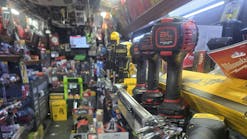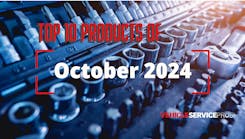Air compressors are used every day in a shop setting, whenever a tool or device needs compressed air to operate. This can be anything from a pneumatic impact, to an air gun for cleaning parts or an air jack used to lift a vehicle.
Instead of having a motor attached to every power tool unit, compressors allow techs to operate a number of different pneumatic tools with the air provided by a compressed air system. This also means that the pneumatic tools themselves do not have a motor and include fewer moving parts to extend the longevity of the tools.
Different types of compressors
When looking at the basic make-up of compressor operation, this shop equipment category is distinguished by the different types of pumps and motors/engines that make up the unit.
There are two types of pump systems that operate compressed air systems: negative-displacement and positive-displacement systems.
Not as common, negative-displacement compressors have a centrifugal pump that uses centrifugal force by spinning a rotating component, known as an impeller, to accelerate and decelerate captured air.
Positive-displacement compressors are the more popular type of compressor pump. According to sources at Jenny Products, a compressed air system manufacturer, positive-displacement compressors “work by filling a chamber with air and then reducing the chamber’s volume.”
Positive-displacement compressors include reciprocating compressors (also known as piston compressors), rotary screw compressors and rotary vane compressors. Rotary compressors are generally used for larger shops, or when more compressed air is needed more frequently, because they work at significantly higher horsepower and flow rates.
Reciprocating compressors are available in single- and double-stage models, referring to the number of pumps on the unit.
“Single-stage air compressors work by drawing air in and subsequently compressing the air to its final pressure in a single piston stroke and can attain pressures up to 150 psi (pounds per square inch),” according to Jenny officials. “Typically, a single-stage pump will have a higher cfm (cubic feet per minute) rating than a two-stage pump because every cylinder is drawing in air and compressing it with air during every rotation.”
The main difference with a two-stage compressor is that there are two steps, or two stages. “Two-stage compressors are normally good for pressures up to 200 psi. Two-stage pumps are more efficient at higher pressures because the air is cooled between the stages.”
Most shops will run a compressor that has an electrical motor, which requires a power source to operate. There are also gasoline engine operated compressors.
“Most electric motor manufacturers rate their motors by the horsepower developed after the motor has come up to its designed operating rpm and disengaged the start windings. Referred to as running horsepower, or rated horsepower, this rating “is a true indication of the horsepower a motor can sustain over a long period of time,” according to reps at Jenny Products.
Conduct an air audit to help determine best unit size for shop
Compressor usage is measured by pressure, via psi, and air flow, via cfm. When determining the size and type of compressor for shop use, it’s important to look at the products in the shop that require air to operate. Pneumatic tools, such as impact guns and ratchets, will have a cfm rating at a specific psi.
An air audit can be as simple as asking a few questions about current usage, futures plans and calculating the consumption of each tool being used in the shop.
“Our distributors don’t sell anything without doing some type of an air audit to get an idea of current needs and future needs,” says David Andrews of Sullair (sullair.com). “If somebody is looking to grow and expand, don’t put in an undersized compressor today and have to double the work tomorrow. Put one in that will meet the needs of the business for the future.”
Although there are expensive tools that can be used to determine air consumption and system leaks, most experts agree the average shop air audit can be done with your eyes and ears. Look at tags on air tools for cfm and listen for leaks.
Representatives at Jenny Products recommend that to determine the cfm rating of the compressor for a shop, add up the required cfm of all air tools that will be used in the shop at the same time, then add an additional 30 percent. This reserve capacity provides a buffer in case the shop is running a few extra tools one day and/or to allow for leaks.
Oftentimes, cfm numbers are also shown at various pressures. These numbers can be very useful to help determine if a compressor produces enough cfm for the desired application, but can be confusing when comparing differing pressures or volumes or different compressors.
Different variables, such as atmospheric pressure, can affect and alter cfm. One way to compare air volume delivery for compressors is through scfm, or standard cubic feet per minute, which measures the flow of free air under a standard set of conditions.
Since all the measurements are calculated back to a set of reference standard conditions, it levels the playing field among the multitude of different manufacturers, according to Jenny Products.
“There are many quick-sizing tools available from manufacturers,” says Richard Campbell, vice president product management North America, compressed air systems and service, Ingersoll Rand. The Compressed Air & Gas Institute (CAGI) has detailed selection guides at www.CAGI.org.
If you want to find leaks, just listen. Go into the shop after hours with everything turned off but the compressor and listen for hissing. Most leaks are audible. Or check the gauge, if you’re losing pressure over time without any tools running, you have a leak.
“Air leaks cost a stunning amount of money because the compressor is running,” says Dan Leiss of Jenny Products. Also the extra run-time is eating away at the compressor’s life. Often the air leaks are simple to fix. Just find the leaks and sell your customer new O-rings, couplers or hoses.
Offer continual service to customers
“Most shops purchase a new compressor at the time when their current unit fails,” says Ingersoll Rand’s Campbell. “At that point, it’s not about price, it’s about who can deliver a new unit quickly and get the shop back up and running.” He suggests dealers carry a trusted compressor brand from your flag or a warehouse that can deliver quickly.
“Pneumatic systems have a finite life before the parts have to be serviced or maintained,” says Ben Echtenkamp, commercial product manager with Campbell Hausfeld. Knowing the life for various components and compressors can help drive the sales, build trust and avoid downtime. “Work with the shop to develop a maintenance/replace schedule that would help for budgeting and planned purchases.”
By continually servicing the current compressed air systems that shops run with fittings, hoses, filters and other consumables, a distributor can remain top of mind for larger equipment purchases and be the first point of contact when a unit fails.
“The time dealers spend training customers on the basics of air compressors is time well spent,” says Campbell. “Helping customers understand cfm, psi, horsepower, electrical – that creates a lot of value. Upselling premium features like low-oil protection switches, auto drain valves and air-cooled after-coolers can help dealers become more profitable.”
No matter how hard you try, often compressor sales will still be made under time pressure. But if you can get just a small percentage of customers to think ahead you can do an air audit and help them plan ahead and buy based on need -- not just in a rush in the midst of an emergency.
Average cfm usage for common shop tools
Information provided by Jenny Products
|
Air Tool Description |
Average cfm @ 90 psi |
|
Angle Disc Grinder - 7" |
5-8 |
|
Cut-Off Tool |
4-10 |
|
Grease Gun |
4 |
|
Hydraulic Riveter |
4 |
|
Impact Wrench - 3/8" |
2.5-3.5 |
|
Impact Wrench - 1/2" |
4-5 |
|
Impact Wrench - 1" |
10 |
|
Mini Die Grinder |
4-6 |
|
Orbital Sander |
6-9 |
|
Ratchet - 1/4" |
2.5-3.5 |
|
Ratchet - 3/8" |
4.5-5 |
*add 30 percent to average cfm to get required cfm


